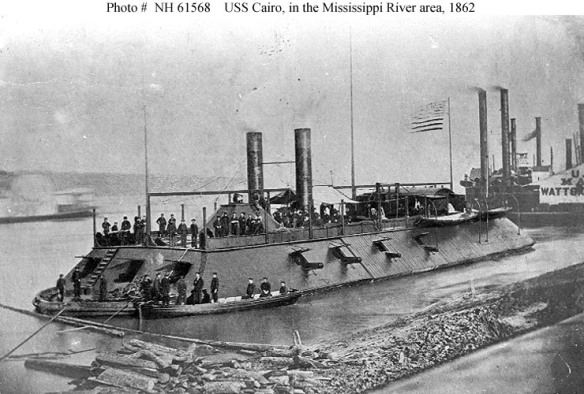
The USS Cairo, lead ship of the Cairo- or City-class of seven river ironclads. These ships were often called “Pook Turtles” for designer Samuel Pook and the shape of the casemate and sloped sides, which gave them a turtle-like appearance. The Cairo was photographed in the Mississippi River in 1862. Note the boat alongside its port bow, crewmen on deck, and other river steamers in the background.
Western industry had already produced gunboats for the Navy at places such as Cincinnati, St. Louis, and Carondelet, Missouri. Some were converted from river steamers and some were built for the purpose, but during 1861 even the vessels purpose-built as gunboats were constructed of wood with iron armor. River navigation demanded shallow draft, so riverboats tended to be built lightly and cheaply, with inefficient engines that took full advantage of the almost inexhaustible supplies of fuel and fresh water. Heavy ships, built entirely of iron, were in fact more of a novelty on the western rivers than on the Atlantic coast.
Cincinnati nominally had a boatbuilding industry upon which to base ironclad construction, but it was neither large nor healthy. In 1859, Charles Cist recorded that the city contained three steamboat yards. Steamboat building, he observed, had been declining for years, and repairing and refitting was the yards’ major occupation. Four hundred men generated $400,000 worth of business. According to the census of 1860, Hamilton County, Ohio (the county in which Cincinnati lay), claimed eleven ship- and boatbuilders with a total product of $265,214. Employment had declined since Cist wrote a year earlier; only 232 hands worked in those eleven yards, fewer than those who made window sashes and well below the number who brewed beer for their living.
In other areas vital to iron shipbuilding, Cincinnati fared better. The city harbored a number of men skilled in the metal trades, including 151 who worked in smithies, 112 brass founders, 1,544 ironworkers, and 1,414 who made “machinery, steam engines, &c.” Across the river in Cincinnati’s Kentucky suburbs of Newport and Covington, another hundred men made iron. Clearly, the city possessed the skilled labor of which the Commercial boasted. The agglomeration of specialist firms made urban Cincinnati a highly favorable environment for custom production.
Cincinnati shipbuilders also had some experience with armored ships. In May 1861, then-Commander John Rodgers had purchased three wooden side-wheel riverboats, which Cincinnati’s Marine Railway and Drydock Company converted into the gunboats Tyler, Conestoga, and Lexington. Later in 1861, the wooden-hulled ironclad gunboats ordered by the Army were designed in Cincinnati by Naval Constructor Samuel Pook, and Rodgers supervised their construction. The seven “City”-class vessels that resulted were all built by James B. Eads in Carondelet and Mound City, Illinois, but Eads’s subcontracting and supply network stretched through Cincinnati and as far as Pittsburgh. The iron armor for his vessels came from three firms, including Alexander Swift & Co. of Cincinnati.
The next group of purpose-built river gunboats, authorized in April 1862, included both wood- and iron-hulled ironclads. The iron-hulled Marietta and Sandusky were to be built by Tomlinson and Hartupee of Pittsburgh, while six more iron-hulled ships were put in hand at St. Louis and the wooden-hulled Ozark was to be built at Mound City. Southern Ohio received a share of this work, as Joseph Brown of Cincinnati built the wooden-hulled Chillicothe, Indianola, and Tuscumbia. Excepting Brown’s vessels, during the year ending September 1, 1862, Cincinnati firms built only four steamboats, aggregating 654 tons.
Even the iron-hulled riverine ironclads were nowhere near as complex and heavy as their seagoing counterparts. The Marietta class, for example, was somewhat broader than the Tippecanoe class but much shorter and shallower. The two Mariettas carried armor only six inches thick on the turrets and 1 1 .2 inches on the sides. Eads’s Milwaukee class, about as long but broader and much shallower than the Tippecanoes, had 8-inch turret armor (equal to the original Monitor) but side armor only 3 inches thick. Because riverine service demanded that everything else be subordinate to shallow draft, all of the river gunboats had relatively light construction and broad, scowlike hulls that disqualified them from oceanic operations.